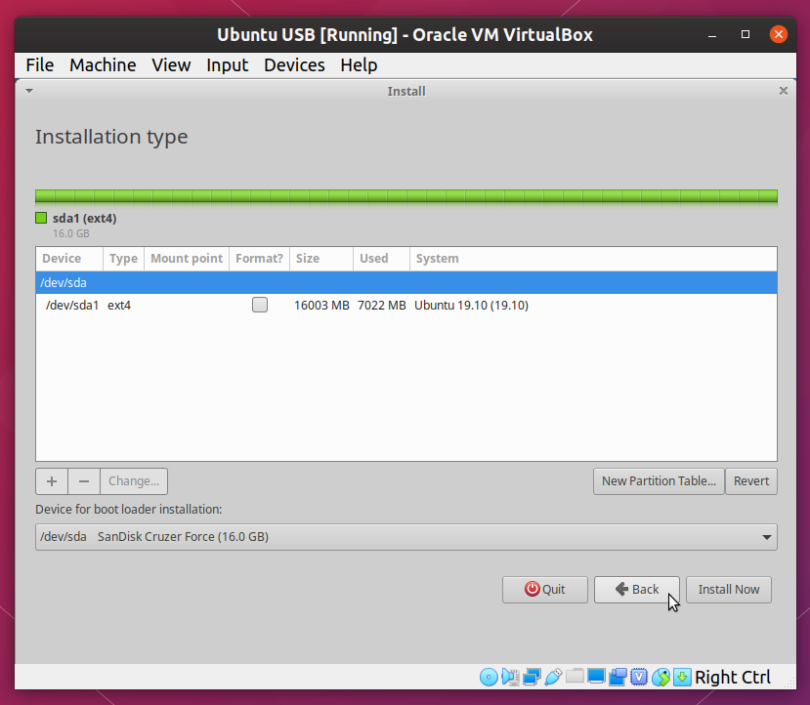

- #Install ubuntu on virtualbox grub boot loader install
- #Install ubuntu on virtualbox grub boot loader code
- #Install ubuntu on virtualbox grub boot loader iso
- #Install ubuntu on virtualbox grub boot loader professional
- #Install ubuntu on virtualbox grub boot loader windows
To install the GRUB boot loader to the MBR of the hard drive, use the following command: grub-install /dev/sda This command will install the GRUB boot loader to the MBR of the first hard drive. This method is more reliable and ensures that the GRUB boot loader is always available. Installing the GRUB boot loader to the MBR of the hard drive is the recommended method.

Install the GRUB boot loader to the /boot/grub directory. Install the GRUB boot loader to the MBR of the hard drive. The GRUB boot loader can be installed on a hard drive in two ways: 1.
#Install ubuntu on virtualbox grub boot loader code
The stage 2 boot loader contains code to load the Kali Linux operating system kernel. The stage 1 boot loader contains code to load the stage 2 boot loader from the /boot/grub directory. The stage 2 boot loader is installed in the /boot/grub directory. The stage 1 boot loader is installed in the Master Boot Record (MBR) of the hard drive. The GRUB boot loader has two main components: 1. The GRUB boot loader loads the operating system kernel and passes control to it. The GRUB boot loader is installed on a special partition on the Kali Linux hard drive. Kali Linux uses GRUB as its default boot loader. Initrd /boot/initrd.img-2.6.GRUB is a boot loader designed to work with a wide range of operating systems. Title Ubuntu 8.04, kernel 2.6.24-16-generic (recovery mode) # menu.lst - See: grub(8), info grub, update-grub(8)

Gvfs-fuse-daemon on /home/rsimms/.gvfs type fuse.gvfs-fuse-daemon cat menu.lst Securityfs on /sys/kernel/security type securityfs (rw) Lrm on /lib/modules/2.6.24-16-generic/volatile type tmpfs (rw) Varlock on /var/lock type tmpfs (rw,noexec,nosuid,nodev,mode=1777)ĭevpts on /dev/pts type devpts (rw,gid=5,mode=620) Varrun on /var/run type tmpfs (rw,noexec,nosuid,nodev,mode=0755) sys on /sys type sysfs (rw,noexec,nosuid,nodev) Proc on /proc type proc (rw,noexec,nosuid,nodev) dev/sda5 on / type ext3 (rw,relatime,errors=remount-ro) Dual-boot Configuration fdisk -lĭisk /dev/sda: 10.7 GB, 10737418240 bytesĢ55 heads, 63 sectors/track, 1305 cylinders When Ubuntu prompts to remove the CD then right click on the little CD icon and select disconnect.Ĭongratulations - Ubuntu is installed and ready to go. Ubuntu has finished copying all the files. Click Continue to confirm.Įnter user information and password, click on Forward.
#Install ubuntu on virtualbox grub boot loader windows
Split the drive evenly between Windows and Ubuntu.Use Los Angeles for Pacific Time Zone, click on Forward. Hit the + key to move the CD-ROM above the hard drive.It should looked like the screen shot above after you move the CD-ROM up. If you are too slow and the OS boots, shut down Windows and try again.ĭon't dawdle - press F2 fast before this screen disappears to change BIOS settings.Ĭhange the boot sequence so the CD-ROM drive is checked before the hard drive for a bootable Operating System.QUICKLY press the F2 key (before OS starts to boot).QUICKLY click inside the Virtual Machine (so it has focus).Step 3 - Change the VM boot sequence order Default Windows install with one partition, quick format.

#Install ubuntu on virtualbox grub boot loader iso
#Install ubuntu on virtualbox grub boot loader professional


 0 kommentar(er)
0 kommentar(er)
